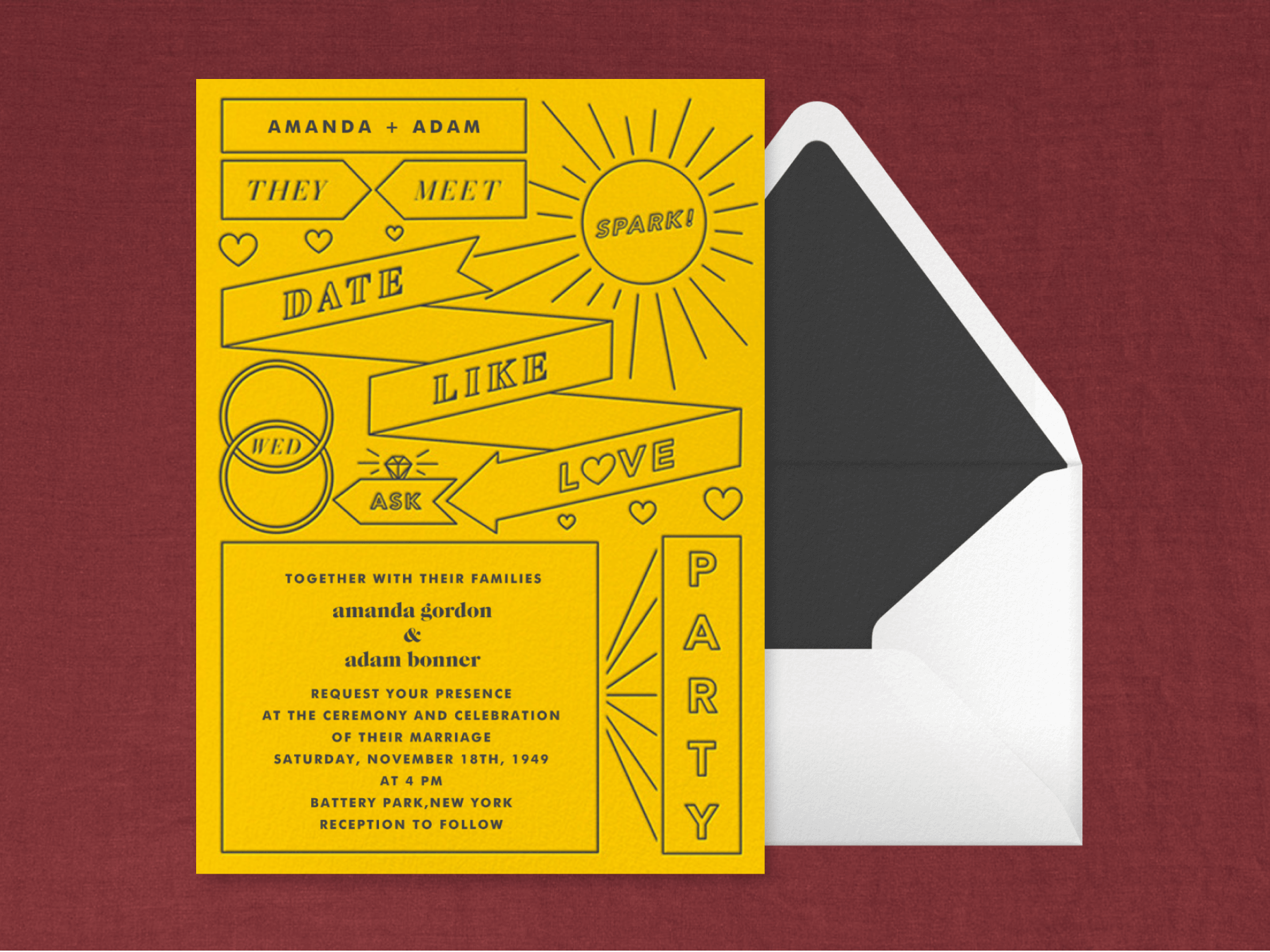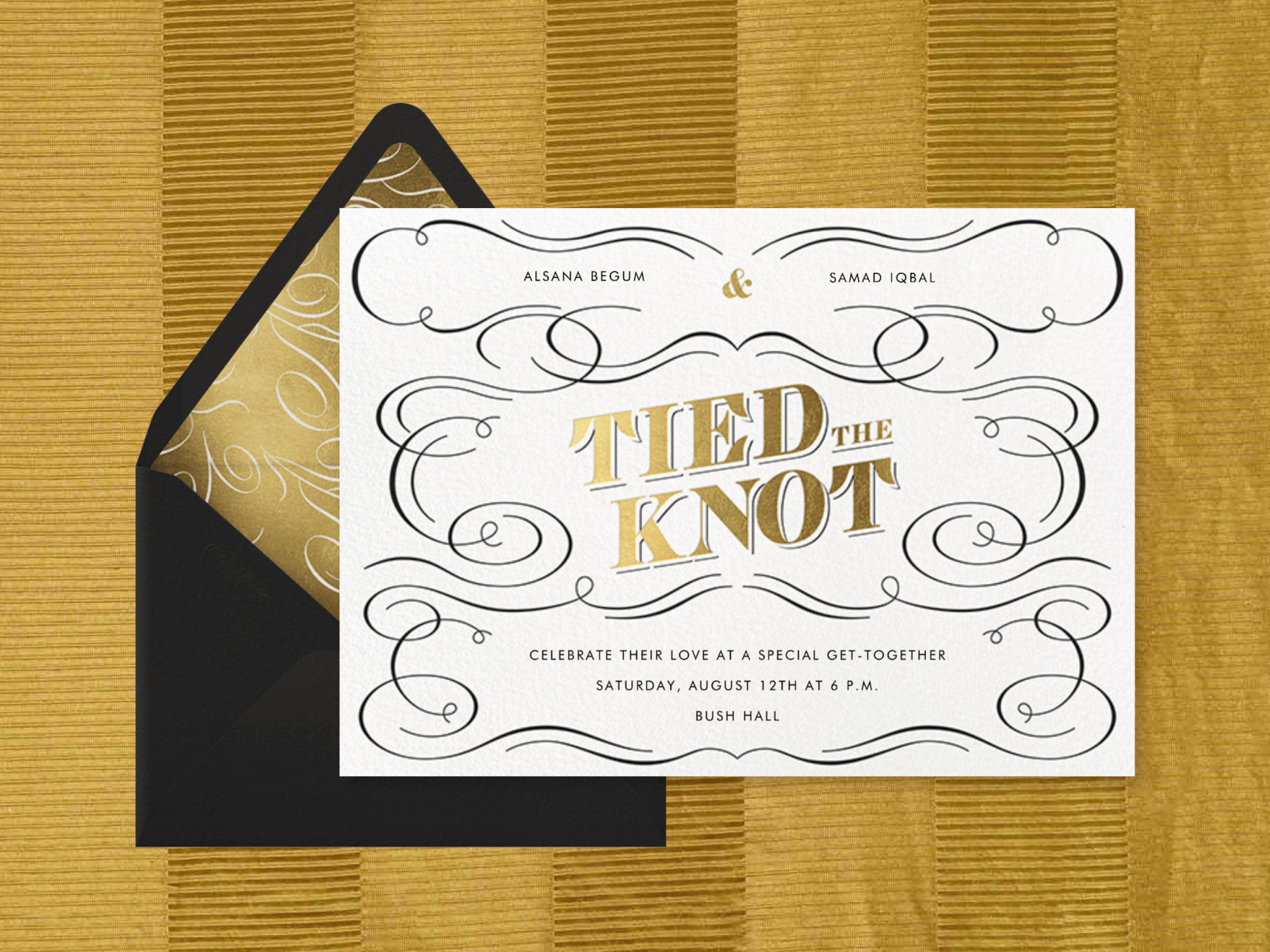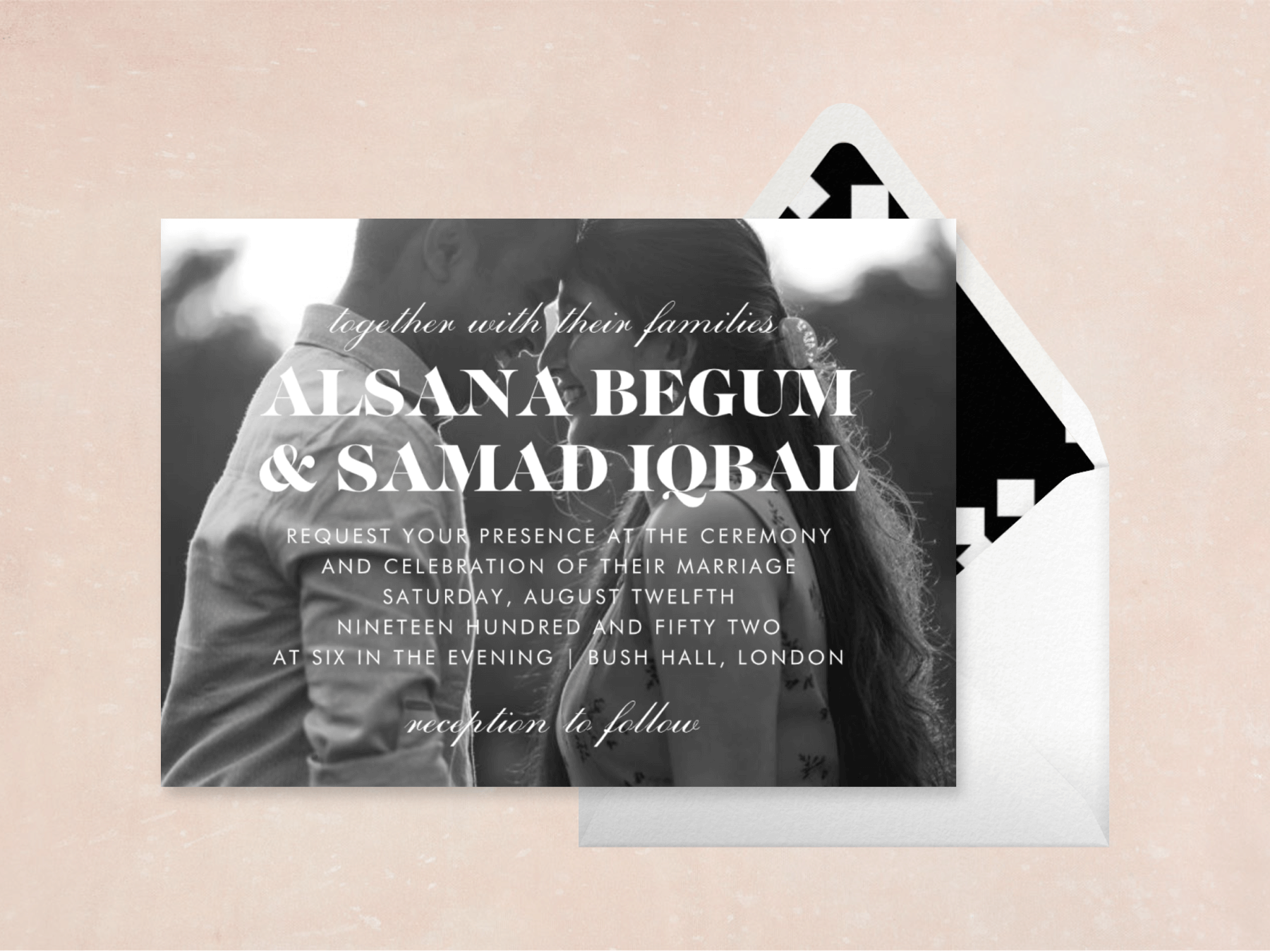Merriment to follow: Your foolproof guide to wedding invitation wording
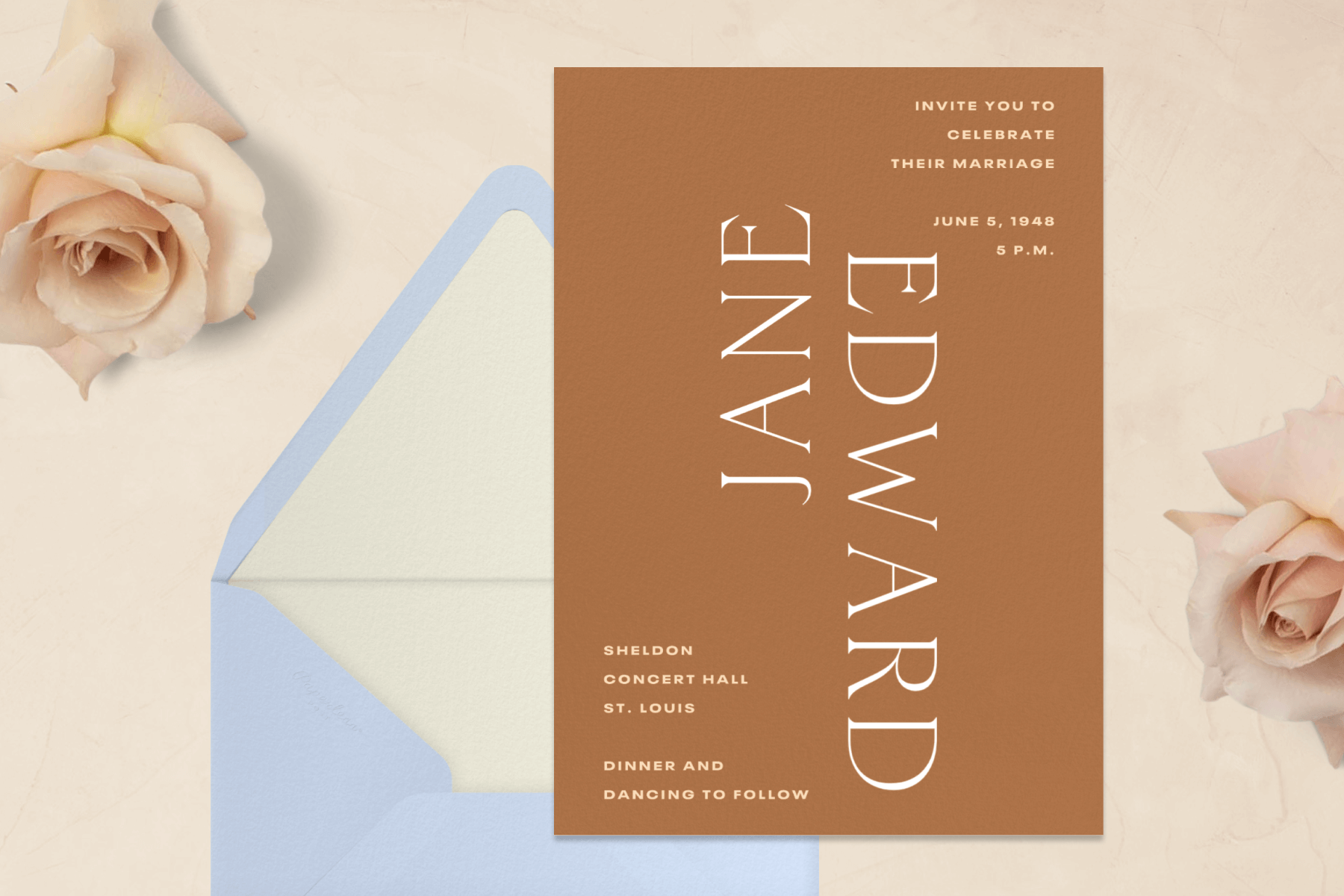
Congratulations on your engagement! Now that you’ve picked a date, it’s time to plan, and wedding invitations are an important part of setting the tone and including your family and friends in your excitement. Planning a wedding is a wonderful opportunity to express your style through decoration and ceremony, and your invitations are the teaser for the celebration to come.
From a multi-day formal wedding to a small gathering of friends, it’s important to be clear with expectations on your invitations. Are children welcome? Can solo guests bring a date? Is there a dress code? These are all questions that can be answered in a well-worded wedding invitation.
Table of Contents
Step-by-step wedding invitation wording
Wedding invitations are steeped in tradition and tend to follow an established format for etiquette, including how you phrase each piece of information. These guidelines are passed down from generation to generation and keeping up with these time-honored standards may be important to you. Or, you can do things your own way and word your wedding invitations in whatever way reflects your style and personality.
We’ve broken down formal and casual wedding invitation wording for the key sections you’ll want to include, so you can decide what feels right for you and your vision for the big day. Whether you’re dreaming of a grand affair, an intimate destination wedding, or looking for specific cultural guidance for Indian wedding invitation wording, we’ve put together helpful options and examples to take the guesswork out of what to say when asking your guests to join you as you say “I do.”
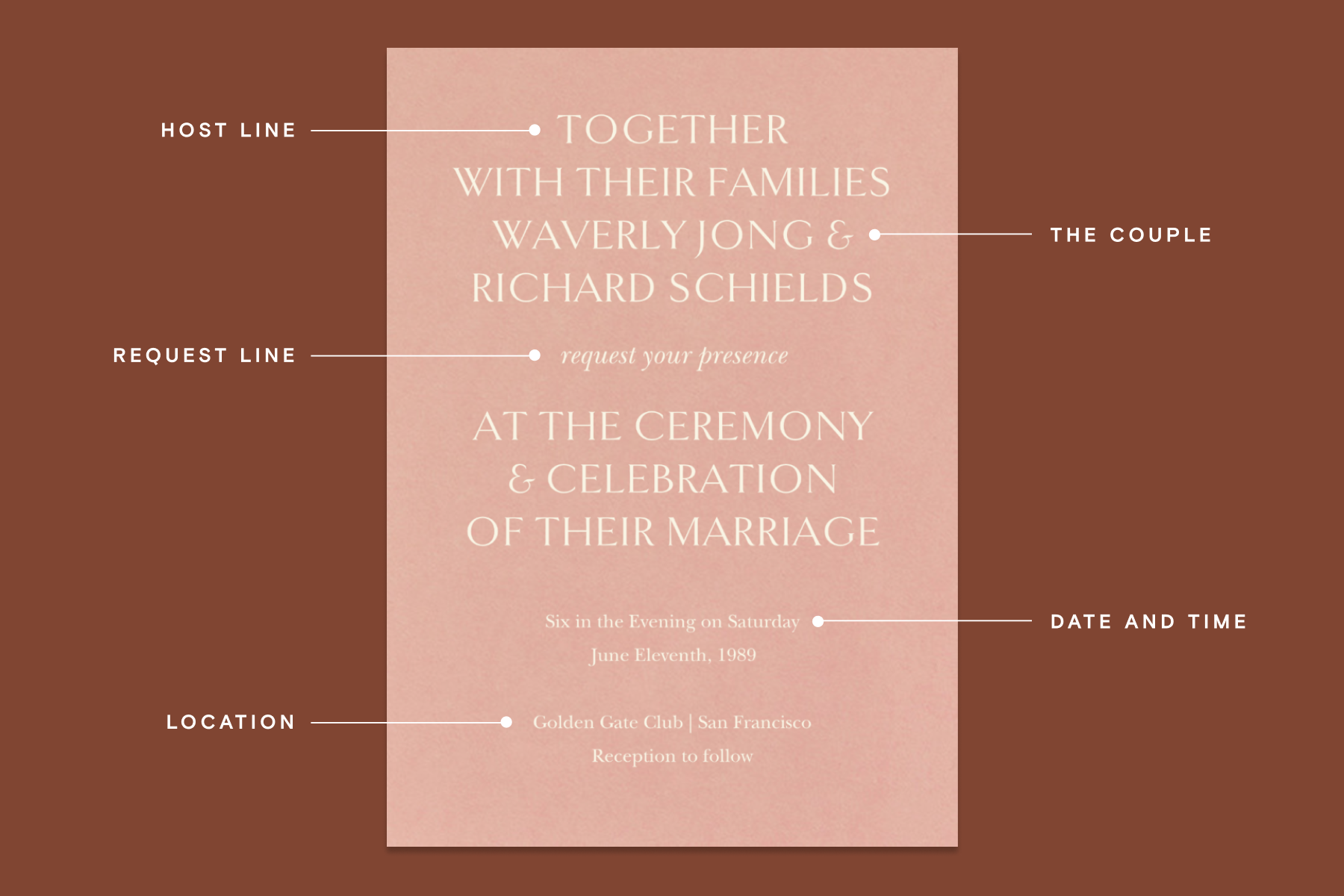 “Oratorio” by Venamour for Paperless Post.
“Oratorio” by Venamour for Paperless Post.
1. The host section
Traditionally, it was the responsibility of the parents of the bride to host the nuptials. Today, there are a few ways to word the host section.
For formal invitations, it’s common for the person hosting the wedding to have the honor of being listed on the invitation as the one inviting people to the wedding.
For example, if the bride’s parents are hosting:
Mr. and Mrs. Benjamin Bradley
cordially invite you to the marriage of their daughter
Grace Marie to Kenneth Chang
When formatting the host section, it’s common to put each couple on a separate line. Unmarried parents also get their own separate line. Traditionally, those with formal titles, like a doctor or other ranking titles, are written first. With so many unique family combinations and blends, there are countless ways to word your host section, and the choice is entirely yours. These are some wedding invitation wording examples to get you started.
If the parents of the bride are hosting and the wife took her husband’s last name:
Mr. and Mrs. Benjamin Bradley
If both the bride and the groom’s parents are hosting and one of them is an MD or Ph.D. and the wife didn’t take her husband’s name:
Dr. John Chang and Mrs. Lavina Truscott
and Mr. and Mrs. Benjamin Bradley
If parents who are divorced and remarried are hosting:
Dr. John Chang and Mrs. Lavinia Truscott
and Mr. Benjamin Bradley
and Mr. Pierre Bezukhov and Mrs. Janet Bezukhov
If both sets of parents and the bride and groom are hosting:
Dr. John Chang and Mrs. Lavina Truscott
and Mr. Kenneth Chang
Mr. and Mrs. Benjamin Bradley
and Ms. Grace Bradley
If there is a parent who is deceased and you wish to include them on the invitation, put them following the couple:
Dr. John Chang and Mrs. Lavina Truscott
and Mr. Kenneth Chang
and Mr. Benjamin Bradley
and Ms. Grace Bradley
and the late Mrs. Janet Bradley
For a modern approach, some couples list themselves as the hosts but give a nod of acknowledgement to their parents or families. For example:
Grace Bradley and Kenneth Chang
together with their families
invite you to the celebration of their marriage
If the wedding is hosted by the engaged couple and you’re not including parents’ names, you can skip the host section and simply include the names of the soon-to-be-spouses.
2. The request line
The request line refers to how you ask your potential guests to join you on your special day. These are some common examples of wedding invitation request wording, but you can choose whatever phrasing feels authentically you:
– Invite you to celebrate
– Request your presence at
– Request the pleasure of your company at
– Invite you to join us online (for a live feed of the ceremony)
– We invite you to join us
3. The names of the couple
Traditionally, the names of the couple include the first and middle name of the bride and the first and last name of the groom. Today, anything goes for wording this section of the wedding invitation, with featuring the first and last names of the couple as the most popular option. If your wedding is a more casual event, dropping last names altogether is a great choice. If the happy couple is the same gender, the names on the invitation can be alphabetical or whatever sounds the best to you.
4. The date and time
For formal wedding invitation wording, the dates and times are spelled out, as in, “Saturday the first of May at three o’clock.” If you’re hosting a more casual celebration, you might choose to show the date and time in numbers, as in, “Saturday, May 1st at 3 pm.” There isn’t a right or a wrong way to phrase this part of an invitation—as long as it’s the correct time and date you’re good to go!
5. The reception
If the reception is taking place at a different location than the ceremony, this section of your wedding invitation lets your guests know where that is and when they should arrive. If the venue is the same, you would mention that here also. “Reception to follow” is common wedding invitation wording for both formal and casual events, written below the location of the ceremony. No matter where your reception is held, include the time in a Schedule Block below your invitation so guests can make arrangements if the party doesn’t start immediately after the ceremony.
6. The dress code
Some couples choose to have a wedding dress code, giving guests guidance and ideas of appropriate attire for the occasion. This can be worded simply, like “formal dress” or “cocktail attire,” for example. If your wedding is formal and you would prefer guests in full-length gowns and tuxedos, use the phrase “black tie.” If you prefer suits and party dresses, use “semi-formal” or “black tie optional,” which indicates that your guests can go all out if they wish.
Tying the knot in a tropical locale? “Beach attire” or “dressy casual” is common invitation wording for destination weddings. The dress code section is also where you would let people know about other considerations, like bringing warm clothing, flat shoes, or a hat and sunscreen.
Using a wedding invitation design that matches your big day’s style will help you set the tone and get guests excited about their attire.
 “Aditri” by Anita Dongre for Paperless Post.
“Aditri” by Anita Dongre for Paperless Post.
7. Additional considerations
This is the part of the wedding invite wording where you inform your guests of other important information. If your wedding and reception are just for adults to attend, you can make it clear in the way you address your invitations. If you’d prefer to be crystal clear to all in attendance, you might include something along the lines of, “Although we love your little ones, this will be an adult-only reception.”
If you have a wedding website, you can include a link at the bottom of your invitation. Traditionally formal invitations don’t include gift registry information, and some couples prefer to include it or give those details on their wedding website. With Paperless Post, you can choose to use Blocks to add details like your registry and venue information below the invitation to keep all of your wedding info in one place. Check out our guide to wedding etiquette tips for more help making sure your invitation is well-received.
8. Addressing your invitations
You’re nearing the finish line of constructing the perfect invitation to send out to your family and friends. Now all that is left to do is follow our simple guide on how to address wedding invitations.
The envelope should indicate specifically who is invited to the wedding. It’s poor etiquette for guests to bring someone who isn’t named on the invitation, unless it’s indicated as a “plus one.” Addressing your invitations to your invitee and a “plus one” or “and guest” is a considerate way to allow someone single to bring a date or a friend to join in your wedding celebration.
Save the date wording
Sending a save the date is an excellent way to let the people you love know that they’ll need to keep the day free to attend your nuptials. It’s a good idea to do this as soon as possible after choosing the date, giving guests as much preparation time as possible.
Include the time and venue, if you’ve selected one. If not, you can indicate “details to follow,” letting them know that they’ll receive all the information in your invitation. The etiquette surrounding save the dates is more relaxed, but if you’re wondering how to word your save the dates, we can help guide you.
Unique wedding invitation wording
If you’re creative and enjoy doing things differently, consider sending out an unconventional wedding invitation that’s as unique as you are as a couple. Invite your guests with something fun and whimsical or choose an invite that showcases your engagement photos. After all, it’s your day, and there is no wrong decision when you go with wedding invitation ideas and wording that speaks to you.
Now that you’re well-versed in wedding invitation wording, you’re ready to find the perfect suite for your ceremony. For expert tips on selecting a wedding venue, head to our interview with the team behind Mavinhouse Events. Incorporate lucky wedding traditions for your big day with our interview with former Martha Stewart Weddings editor Eleni Gage.
